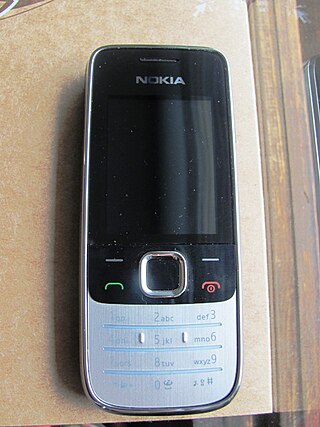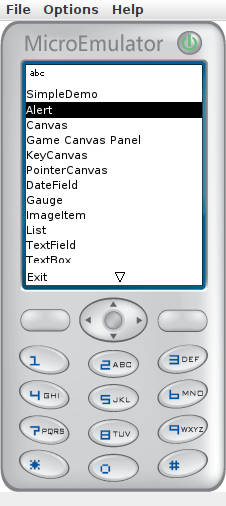Java Platform, Micro Edition or Java ME is a computing platform for development and deployment of portable code for embedded and mobile devices. Java ME was formerly known as Java 2 Platform, Micro Edition or J2ME.
Mobile Information Device Profile (MIDP) is a specification published for the use of Java on embedded devices such as mobile phones and PDAs. MIDP is part of the Java Platform, Micro Edition framework and sits on top of Connected Limited Device Configuration (CLDC), a set of lower level programming interfaces. MIDP was developed under the Java Community Process. The first MIDP devices were launched in April 2001.
The Connected Device Configuration (CDC) is a specification of a framework for Java ME applications describing the basic set of libraries and virtual-machine features that must be present in an implementation. The CDC is combined with one or more profiles to give developers a platform for building applications on embedded devices ranging from pagers up to set-top boxes. The CDC was developed under the Java Community Process as JSR 36 and JSR 218.
The Connected Limited Device Configuration (CLDC) is a specification of a framework for Java ME applications describing the basic set of libraries and virtual-machine features that must be present in an implementation. The CLDC is combined with one or more profiles to give developers a platform for building applications on embedded devices with very limited resources such as pagers and mobile phones. The CLDC was developed under the Java Community Process as JSR 30 and JSR 139.

Maemo is a Linux-based software platform originally developed by Nokia, now developed by the community, for smartphones and Internet tablets. The platform comprises both the Maemo operating system and SDK. Maemo played a key role in Nokia's failed strategy to compete with Apple and Android; the only retail devices that shipped with Maemo were the Nokia Internet tablet line released in 2005 and the Nokia N900 smartphone in 2009.
The Mobile Media API (MMAPI) is an API specification for the Java ME platform CDC and CLDC devices such as mobile phones. Depending on how it is implemented, the APIs allow applications to play and record sounds and video, and to capture still images. MMAPI was developed under the Java Community Process as JSR 135.
Mobile app development is the act or process by which a mobile app is developed for one or more mobile devices, which can include personal digital assistants (PDA), enterprise digital assistants (EDA), or mobile phones. Such software applications are specifically designed to run on mobile devices, taking numerous hardware constraints into consideration. Common constraints include CPU architecture and speeds, available memory (RAM), limited data storage capacities, and considerable variation in displays and input methods. These applications can be pre-installed on phones during manufacturing or delivered as web applications, using server-side or client-side processing to provide an "application-like" experience within a web browser.
Java Application Descriptor (JAD) files describe the MIDlets that are distributed as JAR files. JAD files are commonly used to package Java applications or games that can be downloaded to mobile phones. Java applications enable mobile phones to interact functionally with online web services, such as the ability to send SMS messages via GSM mobile Internet or interact in multiplayer games. Some BlackBerry devices use JAD files for themes, while on some mobile phones without memory cards it is not possible to download any apps.
Perst is an open source, dual license, object-oriented embedded database management system (ODBMS). Both the Java programming language, and the C# programming language versions are compact and Perst has been implemented on smart phones running the Android and Windows Phone (WP7) operating systems.
Go Bible is a free Bible viewer application for Java mobile phones. It was developed by Jolon Faichney in Surf City, Gold Coast, Queensland, Australia, with help from several other people who assisted in making versions for other languages and translations. Go Bible is installed like any other midlet by copying the .jar and .jad file to the cell phone by USB or Bluetooth. The English KJV Go Bible 1.1 can also be installed using WAP download.
The phoneME project is Sun Microsystems reference implementation of Java virtual machine and associated libraries of Java ME with source, licensed under the GNU General Public License.
Mika VM is an open-source implementation of the Java virtual machine specification, together with class libraries which implement the Connected Device Configuration of Java ME. Mika VM is based on Wonka VM, which was developed independently of any other implementation, including Sun Microsystem's RI. The same is true of most of the class libraries, but in this case some code is drawn from the GNU Classpath and Apache Harmony projects. MikaVM support MIDP 1.0 and 2.0, CDC Personal Profile.

Vision was a mobile browser developed by Novarra Inc. that ran on Java Platform, Micro Edition. It was first released in 2002, and the final release was in 2009.

The Nokia 3720 classic is a mobile phone by Nokia announced in July 2009 and manufactured in Hungary. The phone runs the Series 40 6th edition platform.

The Nokia N900 is a smartphone made by Nokia, launched at Nokia World on 2 September 2009 and released in November. Superseding the Nokia N810, the N900's default operating system, Maemo 5, is a Linux-based OS originally developed for the Nokia 770 Internet Tablet. It is the first Nokia device based upon the Texas Instruments OMAP3 microprocessor with the ARM Cortex-A8 core. Unlike the three Nokia Internet tablets preceding it, the Nokia N900 is the first Maemo device to include telephony functionality.

The BOLT Browser was a web browsing system for mobile phones including feature phones and smartphones able to run Java ME applications. The BOLT browser was installed on the phone, and BOLT servers accessed Web pages, processed and compressed them, and delivered them to phones running the browser. The BOLT Browser was offered free of charge to consumers, and by license to mobile network operators and handset manufacturers. BOLT was produced by Bitstream Inc., the company which previously produced ThunderHawk for mobile network operators and handset manufacturers. BOLT was originally introduced into private beta on January 15, 2009 and was made available to the public on February 16, 2009 when the public beta was announced at Mobile World Congress in Barcelona. BOLT supported Java-based handsets with Java MIDP 2 and CLDC 1.0 or higher. BOLT also has specially optimized version for BlackBerry smartphones and worked with Windows Mobile and Palm OS devices that employ a MIDlet manager or Java emulator. BOLT was built using the WebKit rendering engine to display a full Web page layout as found on desktop web browsers.

The Nokia 2730 classic is a Nokia Quad-band GSM/UMTS 3G cell phone that includes a camera, FM radio, Bluetooth, music and video player, as well as several internet-based applications.
The Mobile 3D Graphics API, commonly referred to as M3G, is an open source graphics API and file format specification for developing Java ME applications that produce 3D computer graphics on embedded devices such as mobile phones and PDAs.
An app store, also called an app marketplace or app catalog, is a type of digital distribution platform for computer software called applications, often in a mobile context. Apps provide a specific set of functions which, by definition, do not include the running of the computer itself. Complex software designed for use on a personal computer, for example, may have a related app designed for use on a mobile device. Today apps are normally designed to run on a specific operating system—such as the contemporary iOS, macOS, Windows, Linux or Android—but in the past mobile carriers had their own portals for apps and related media content.

MicroEmulator — is a free and open-source platform independent J2ME emulator allowing to run MIDlets on any device with compatible JVM. It is written in pure Java as an implementation of J2ME in J2SE.








